Heyooo, welcome back to Voracious Gamer. Today we begin a new series covering The Drowned Earth Beta 1.0. A Kickstarter will begin for the game in April of this year. Let’s crack the digital spine on this beast and see what we’re all in for. As always I’ll work my way through the book in my unique verbose way and we’ll see what unfolds. Grab the open beta materials here.
The beta is 85 pages and I’m really digging the front cover. Several dinosaurs on the fringes of a devastated waterfall filled city with a crew taking a small boat out into the unknown.
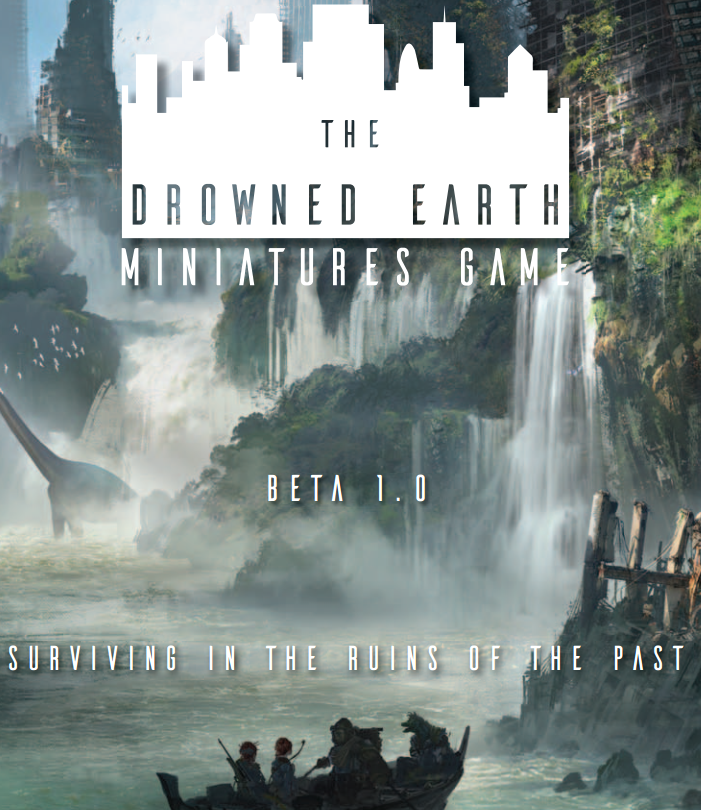
The book starts with a brief preface on the origins of the game and the process the creator James Baldwin is using to make this project a reality via Kickstarter. He puts a very personal spin on things here you can tell this is his baby and he cares a lot about in his words ‘an unambiguous and tight rules set’. The game itself will have a Skirmish mode and a Narrative mode. This Beta however only details the rules for the Skirmish mode. James goes on to explain his reasoning. Focusing on the rules themselves and getting the skirmish mode going is a task itself. The skirmish mode will need to be ironed out before he can flesh out the campaign mode with experience, upgrades and narrative events. It’s probably one of the best preface’s I’ve read about the state of the game and what it means to the creators. I’m not comparing it to much I suppose but It’s good nonetheless to learn about the project before diving in!
Next up we’ve got a little intro to the continent Ulaya and it’s relations on The Drowned Earth. Basically some cataclysmic event has taken out the previous society hundreds of years ago. The planet’s waters have risen and most of it is swampy and jungle like now with ruins of the past indecipherable and rotting. Once again society is emerging from that which society emerges from, building cities and establishing trade routes. Some are even utilizing some of the relics of the Builders the past civilization. Agriculture is starting to boom along with it the emergence of land disputes and slavery. Giant creatures stalk the misty realms some forgotten experiments of the past age left to roam and develop on their own. Looks like dinosaurs to me on the cover! Ha, it’s a good intro to the world and he mentions some of the rest of the world as well.

We’re get dug in nice and proper now with a backdrop and enough tidbits of fluff to get the wheels spinning. TDE is an alternating activation miniatures game for two players using small crews of 5 to 15 minis. In Skirmish play a point value is determined and players build their crew to the specified limits. As far as terrain goes it’s a swampy jungley horror land folks. I’m thinking fish tank stuff and ruined buildings galore. They point out that the best games are played with dense multi-level terrain including water features to allow characters to jump, climb and swim. I can see a narrative element there for sure. He also mentions that shooting is ‘Brutal’ in this game so you’ll want cover to hide from and sneak up on your opponent.
The first rule is the synonymous disclaimer that we’re all here to have fun and both players should be having a good time. Keeping things friendly and such. Distance and range is from the edge of one model to the nearest edge of whatever you’re measuring. Pre-measuring is allowed at any time. TDE uses true line of sight. Since models are sculpted dynamically you’ve got to see the head to the ‘core’ of the model like torso and lower limbs. Roll to decide if players disagree here. It seems like models sculpted smaller or crouching have an advantage here without some kind of abstract mechanism for drawing line of sight but let’s be patient and let the book do its job in teaching before we get to questioning. Models have no facing so they can draw LoS in any direction.
As is common in many games when given the option to re-roll a die you may not reroll it again. Some mechanics allow you to modify rolls but ‘Feat’ and ‘Blunder’ results on rolled tests may not be modified. The five results of test made in TDE to determine success are ‘Blunder, Fail, Pass, Nailed it and Feat. A successful test means you got a Pass, Nailed it or Feat result. The players take turn activating models one at a time exchanging who is the active and inactive player with each activation.
Some mechanics in the game will call for scattering, to do so there is a scatter template to use, 1 should point towards the board center then a d10 (the games’ dice currency of choice) is rolled to determine the direction of the scatter. Distance can be stated or also rely on a dice roll. Remember the 0 side of the d10 is a 10! If you need to roll a d5 divide the d10 by two and round down. Models are in base contact if there are touching bases. A nifty thing that I’ve yet to see in a game is to consider the models base an inch tall so models can be on different elevations and still be in base to base. You can’t take shoot actions when in base to base nor can you be the target of a shoot action.
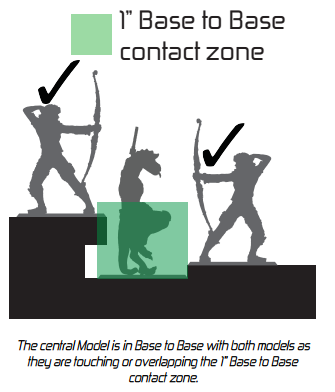
If you’re taking a move action and you end up falling, or getting a Fail or Blunder result that puts you in base to base with an enemy just stop an inch from them while staying as close as possible to the original spot. Next we’ll dive into the Character Profiles themselves.
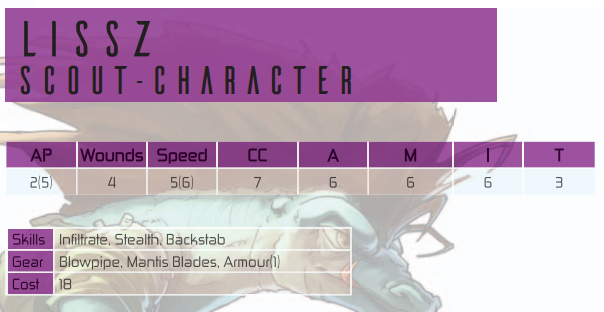
Above we’ve got the stat block for Lissz a scout for the faction called ‘The Firm’. Scout is the models’ Role some other possible roles are Medic, Mech, Tough, Captain and Heavy. ‘Character’ is the models Class and there are only three class types in TDE. Characters, Troops and Beasts. Moving down into the stat line proper we’ve got AP (action points) the first number is the amount generated per turn and the bracketed number is the max AP the model can have at any time. Next Wounds are.. Well they’re wounds. A model is ‘wounded’ if it has less than its original amount of wounds remaining and they are considered ‘down’ when reduced to zero. Speed is next the two numbers represent ‘Pass’ speed and ‘Nailed It’ speed. Certain actions and game mechanics will call for either.
The next five columns we have are the Attributes. These are used to actually make the tests we’ve been mentioning. CC is close combat, A is agility, M is marksmanship, I is intelligence and T is toughness. Next on the card are the skills. These are special traits and abilities that make the model unique in TDE and we’ll touch on specifics later. We can see that Lissz has Infiltrate, Stealth and Backstab for skills. Then we have gear what tools the character has for surviving the aquatic wastes and humid swamps of Ulaya. Let’s wrap up this post with Details on dice rolls and the aforementioned attribute tests.
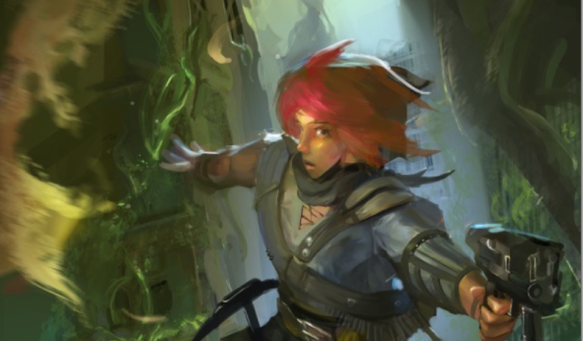
To make an attribute test you’ll need two d10s that are not the same color. Both are rolled to make an attribute test. One die (you decide which before rolling) is the Attribute Die and the other is the Feat Die. You want to roll equal to or under the attribute being tested. You want both die to be equal to or under the number and the results of the test are change whether one, none or both die succeeded.
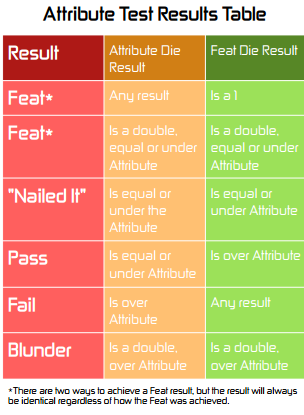
So looking at the chart atop imagine Lissz was rolling an attribute test with agility to avoid falling off a ledge (he’s up there being sneaky of course.) His agility is 6, he rolls both dice and consults the table to see where his roll qualifies. Feats’ count as ‘Nailed It’ but they give you a feat bonus as well. Remember ‘Nailed It’ results use the second number on the stat line if there is one. Sometimes test will require more than one attribute test it’s important to note that you can only ever take 1 ‘Nailed It’ success on an action. (more on this later, stick with me). Now before I go on to explain more about Feat, blunder, pass and fail take a look at this chart to clear up how the tests and results are determined. I’m guessing the creator may be in IT because this is very similar to a Business Process Document. IT or not it’s helpful beyond belief to see how the tests work.
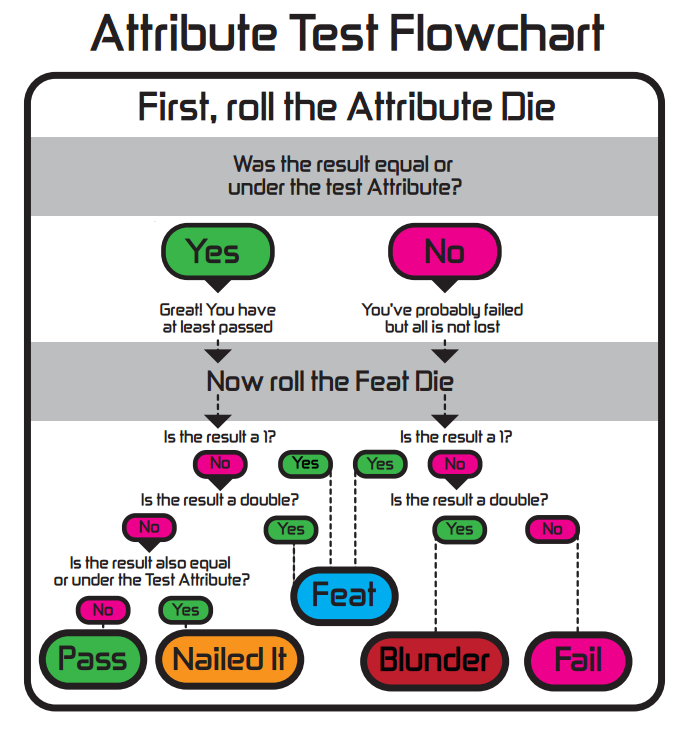
Now I’m assuming once you are more comfortable with the rules you can roll both die at the same time but this chart will probably be bread and butter for the first game or too. So a ‘Feat’ is a ‘Nailed it’ result but one that also grants a bonus AP! The ‘Blunder’ result is worse than a fail. Specific tests have Blunder effects think a weapon jamming when you shoot or tripping before leaping across a chasm. If the specific test being taken doesn’t have a blunder effect then treat is a normal fail.
Attribute modifiers can be negative or positive, like +1 to toughness for hard cover during an armor roll. These attribute mods are only for the roll and don’t make any permanent changes to the attribute. A modifier may never be raised above 9 or lower than a 1.
All the tests we’ve discussed have been a model rolling against their own attribute but many tests will require an opposed test where both models roll their test at the same time and compare their success levels. The losing player’s action here automatically fails for example Lissz shoots Sage by taking a marksmen test while Sage tries to dodge taking an agility test. When it comes to which success level wins this it the hierarchy. ‘Feat’ beats a ‘Nailed it’ which beats a Pass. If both models tie the highest successful dice roll wins, do don’t pick up your dice after rolling! In a tie both models succeed which means Lissz would shoot sage AND he would dodge both actions happen.
That’s all she wrote for part 1 of the series. In the next post we’ll go through the Game Sequence itself, actions and activations. Follow me @vorgames and follow The Drowned Earth @TheDrownedEarth .
Happy gaming friends.
[…] Learnin’ The Drowned Earth Beta 1.0 Part 1, Stats and Mechanics […]
LikeLike
[…] Learnin’ The Drowned Earth Beta 1.0 Part 1, Stats and Mechanics […]
LikeLike
[…] Learnin’ The Drowned Earth Beta 1.0 Part 1, Stats and Mechanics […]
LikeLike